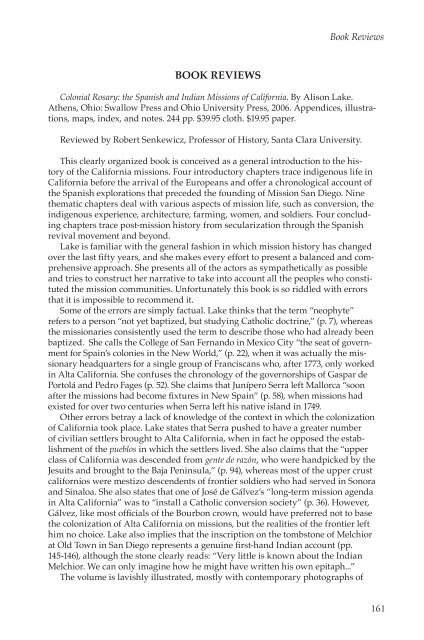The Journal of San Diego History - San Diego History Center
The Journal of San Diego History - San Diego History Center
The Journal of San Diego History - San Diego History Center
You also want an ePaper? Increase the reach of your titles
YUMPU automatically turns print PDFs into web optimized ePapers that Google loves.
Book Reviews<br />
BOOK REVIEWS<br />
Colonial Rosary: the Spanish and Indian Missions <strong>of</strong> California. By Alison Lake.<br />
Athens, Ohio: Swallow Press and Ohio University Press, 2006. Appendices, illustrations,<br />
maps, index, and notes. 244 pp. $39.95 cloth. $19.95 paper.<br />
Reviewed by Robert Senkewicz, Pr<strong>of</strong>essor <strong>of</strong> <strong>History</strong>, <strong>San</strong>ta Clara University.<br />
This clearly organized book is conceived as a general introduction to the history<br />
<strong>of</strong> the California missions. Four introductory chapters trace indigenous life in<br />
California before the arrival <strong>of</strong> the Europeans and <strong>of</strong>fer a chronological account <strong>of</strong><br />
the Spanish explorations that preceded the founding <strong>of</strong> Mission <strong>San</strong> <strong>Diego</strong>. Nine<br />
thematic chapters deal with various aspects <strong>of</strong> mission life, such as conversion, the<br />
indigenous experience, architecture, farming, women, and soldiers. Four concluding<br />
chapters trace post-mission history from secularization through the Spanish<br />
revival movement and beyond.<br />
Lake is familiar with the general fashion in which mission history has changed<br />
over the last fifty years, and she makes every effort to present a balanced and comprehensive<br />
approach. She presents all <strong>of</strong> the actors as sympathetically as possible<br />
and tries to construct her narrative to take into account all the peoples who constituted<br />
the mission communities. Unfortunately this book is so riddled with errors<br />
that it is impossible to recommend it.<br />
Some <strong>of</strong> the errors are simply factual. Lake thinks that the term “neophyte”<br />
refers to a person “not yet baptized, but studying Catholic doctrine,” (p. 7), whereas<br />
the missionaries consistently used the term to describe those who had already been<br />
baptized. She calls the College <strong>of</strong> <strong>San</strong> Fernando in Mexico City “the seat <strong>of</strong> government<br />
for Spain’s colonies in the New World,” (p. 22), when it was actually the missionary<br />
headquarters for a single group <strong>of</strong> Franciscans who, after 1773, only worked<br />
in Alta California. She confuses the chronology <strong>of</strong> the governorships <strong>of</strong> Gaspar de<br />
Portolá and Pedro Fages (p. 52). She claims that Junípero Serra left Mallorca “soon<br />
after the missions had become fixtures in New Spain” (p. 58), when missions had<br />
existed for over two centuries when Serra left his native island in 1749.<br />
Other errors betray a lack <strong>of</strong> knowledge <strong>of</strong> the context in which the colonization<br />
<strong>of</strong> California took place. Lake states that Serra pushed to have a greater number<br />
<strong>of</strong> civilian settlers brought to Alta California, when in fact he opposed the establishment<br />
<strong>of</strong> the pueblos in which the settlers lived. She also claims that the “upper<br />
class <strong>of</strong> California was descended from gente de razón, who were handpicked by the<br />
Jesuits and brought to the Baja Peninsula,” (p. 94), whereas most <strong>of</strong> the upper crust<br />
californios were mestizo descendents <strong>of</strong> frontier soldiers who had served in Sonora<br />
and Sinaloa. She also states that one <strong>of</strong> José de Gálvez’s “long-term mission agenda<br />
in Alta California” was to “install a Catholic conversion society” (p. 36). However,<br />
Gálvez, like most <strong>of</strong>ficials <strong>of</strong> the Bourbon crown, would have preferred not to base<br />
the colonization <strong>of</strong> Alta California on missions, but the realities <strong>of</strong> the frontier left<br />
him no choice. Lake also implies that the inscription on the tombstone <strong>of</strong> Melchior<br />
at Old Town in <strong>San</strong> <strong>Diego</strong> represents a genuine first-hand Indian account (pp.<br />
145-146), although the stone clearly reads: “Very little is known about the Indian<br />
Melchior. We can only imagine how he might have written his own epitaph...”<br />
<strong>The</strong> volume is lavishly illustrated, mostly with contemporary photographs <strong>of</strong><br />
161






![[PDF] The Journal of San Diego History Vol 52: Nos 1 & 2](https://img.yumpu.com/25984149/1/172x260/pdf-the-journal-of-san-diego-history-vol-52-nos-1-2.jpg?quality=85)

![[PDF] The Journal of San Diego History - San Diego History Center](https://img.yumpu.com/25984131/1/172x260/pdf-the-journal-of-san-diego-history-san-diego-history-center.jpg?quality=85)







